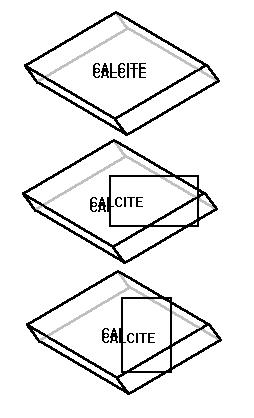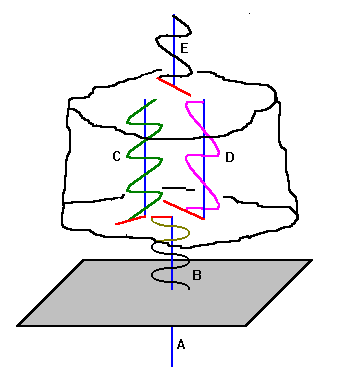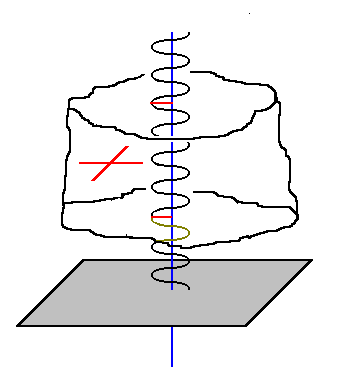Polarized Light in Crystals
Steven Dutch, Professor Emeritus, Natural and Applied Sciences, University of Wisconsin - Green Bay
Double Refraction
 | In most crystalline materials, light splits into two beams that travel in different directions at different speeds. This phenomenon is called double refraction. The beams of light are polarized at right angles to each other. In most minerals the difference is too small to see without optical aid, but calcite shows dramatic double refraction. If you observe calcite through a polarizing filter, the doubled images blink in and out as you rotate the polarizer, confirming that the two images are made of light polarized in perpendicular directions. These directions are called the privileged directions. Before cheap plastic polarizers became available, the best source of polarized light was a prism of calcite cut so that one beam passed through but the other was reflected away. Since the beams only diverge by a few degrees, the prism had to be very precisely manufactured. Also, given calcite's good cleavage, it was quite fragile. Such a prism was called a Nicol Prism and mineralogists still often refer to crossed polarizers as "crossed Nicols." |
 | When light enters a crystalline material with double refraction, it splits into two beams that travel at slightly different speeds. That is, they have slightly different indices of refraction. Generally the variation is only a few per cent. Unpolarized light (A) passes through polarizer B and becomes polarized. When it enters a crystalline material, it splits into a slow ray (C: higher refractive index) and a fast ray (D: lower refractive index). When these rays exit the crystal (E) they recombine into a single ray. Their electric field vectors add together and the result usually does not have the same orientation as the initial beam. If there is a second polarizer above the material at right angles to the first, some of the exiting light will pass through it. The material will not be black as would be the case if we simply looked through two crossed polarizers. |
Extinction
 | When one privileged direction of the mineral is parallel to the bottom polarizer, the light splits into two components with perpendicular polarizations, but the component perpendicular to the incoming polarized light is zero. The light exits with the same polarization as when it entered, and is blocked by the upper polarizer. Under the microscope, as the specimen is rotated 360 degrees, it has a privileged direction parallel to the bottom polarizer every 90 degrees. No light gets through the upper polarizer, the specimen appears black, and is said to be at extinction. At all other orientations, some light is transmitted by the upper polarizer, with maximum transmission at 45 degrees to the extinction directions. |
The good news is you can tell instantly what are the privileged directions in amineral. However, that information may not always be very useful. It's most useful if youcan also see crystal features like cleavage or crystal shape, because the relation betweenprivileged direction and crystal form is often diagnostic.
Pleochroism
In most cases, we don't remove the lower polarizer because the appearance of mineralsis pretty much the same in plane-polarized light as in ordinary light. Colored minerals,however, often show a variation in color depending on the vibration direction of the lightpassing through them. This variation is called pleochroism.
Many pleochroic minerals simply show a variation from lighter to darker color as thespecimen is rotated. Others can change color completely. Some minerals can go from nearlyclear in one orientation to nearly black at others and are in effect natural polarizingfilters. Tourmaline is one such mineral and was sometimes used for that purpose.Pleochroism is a valuable diagnostic feature of minerals.
Return to Mineralogy-Petrology Index
Return to Thin-Section Index
Return to Crystals and Light Index
Return to Crystal Structures Index
Return to Mineral Identification Tables
Return to Professor Dutch's Home Page
Created 7 Oct 1997, Last Update 30 November 1999